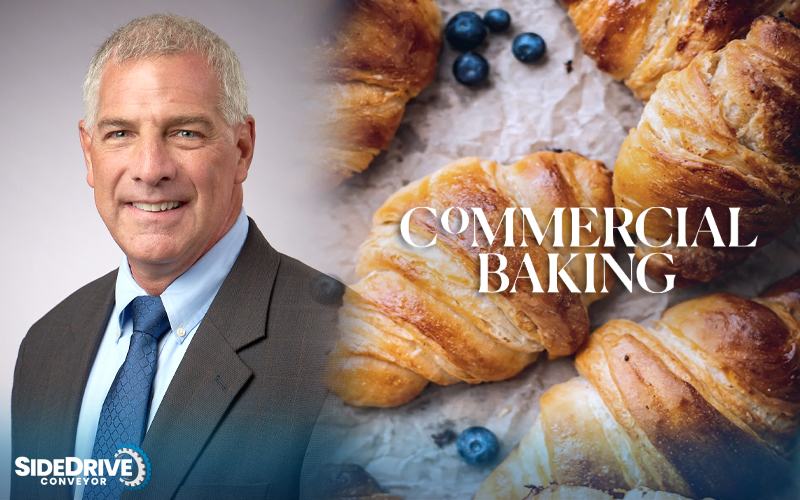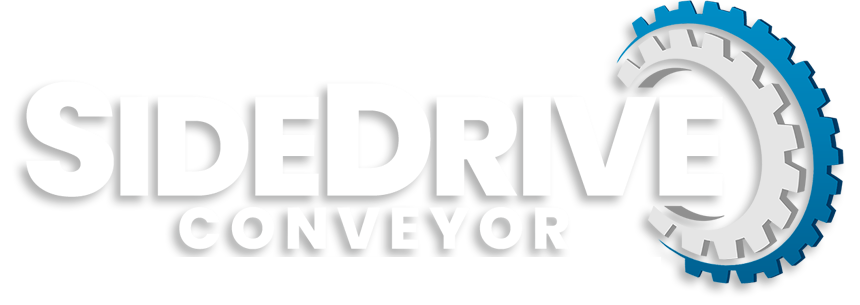6 min read
TechTalk: Improving Productivity and Sanitation for Manual Tray Handling in Commercial Baking
By: Tony Maniscalco on Dec 5, 2023 8:45:00 AM

Tony Maniscalco, our national sales manager, had the chance to discuss ways automation can help improve productivity and sanitation in commercial bakeries with Joanie Spencer, editor-in-chief of Commercial Baking. Check out the video or feel free to read the transcription below.
In this TechTalk I am speaking with Tony Maniscalco, National Sales Manager of SideDrive Conveyors, and we are discussing the ways automation can help improve productivity and sanitation for manual tray handling.
Tony: Great Joanie, thanks for the invitation, I really appreciate it.
Joanie: So I want just to dive right in because this is a really important topic, and I just want to first ask you: What are the signs that a bakery is ready to automate their tray rack system? What should they be looking out for?
Tony: Right. Yeah, this is an interesting topic in the industry. A lot of customers are coming to us for it. There are a variety of reasons to automate, but the most common include increased product demand, need to increase throughput, lack of available labor for the bakery, need to improve the quality and consistency of products, optimizing space and improve ergonomics in safe conditions are some of the key points they are looking for. There are a couple of examples the traditional tray and rack system introduced many variables into the process that could influence productivity and quality; many bakeries are going through a phase of growth and it requires optimizing the process to keep up with the growing demand. Transferring baking trays to racks and moving them around a bakery isn’t efficient, and it depends on resources which means, you could either forget, get busy, or make a mistake. So passive automated process would improve the operations to ensure the product sits, rises, cools, and cures perfectly every time.
Joanie: You know, it is amazing how bakery operation has evolved, this industry has really evolved. So when you look at all these factors and things to look out for, once a baker determines they are ready to move into automation, how do you get that system automated? Basically, what’s the first step?
Tony: Bringing automation with passive processes to the bakery floor- it’s a great way to increase your efficiency. First, we would review the current process and application, as anybody would, and that’s to determine the best design we can offer- with our equipment the SideDrive Conveyor Spiral. The flexibility of a spiral design can fit into your existing infrastructure and it can support all of the critical proofing, curing, and dwell time tasks according to recipes. Our conveyors are configurable and ideal for baking processes that require handling while going up and over and down, or in or out of bakery equipment. We also have power transfers for smooth transition handling products on and off of the Spiral and even a transferless conveyor for small cookies and pretzels and things of that nature that could be considered with this design and it would eliminate any transfer points from going from one machine to the next.
Joanie: What are the different configurations for the Spiral conveyors that can help with this manual tray process?
Tony: Another good question. There are two that come to mind, and possibly a third, depending on the situation. We could configure the SideDrive Conveyor into what’s called a “P-Loop” and essentially that would allow the product whether in a tray or in contact with the belt, to be elevated up and down in the same sanitary structure. The second one would be an Alpine arrangement. Basically, there is an elongated spiral to support any type of extended process and time requirements. Both could be used for cooling, curing, and proofing processes. A third rather unique thing we have is a transfer of the conveyor that can extend from one machine to another without any transfer points; especially important when product loss is an issue as our conveyors are modular in design. You can match different solutions with your existing bakery processing equipment and we can help elevate, and lower the rate to any level for a smooth transition, entries into ovens, freezers, or any other downstream processing station that’s required.
Joanie: That modularity just sort of creates unlimited options, really.
Tony: Absolutely.
Joanie: Incredible. Yeah, and that’s what bakeries need right now more than anything, is flexibility.
Tony: Absolutely.
Joanie: So, there’s something else that we can’t have a conversation about Conveyor Systems without talking about it, and that’s sanitation. So, in a bakery operation, product changeover and more specifically cross-contamination are a huge concern. So, how do your systems create a hygienic environment?
Tony: There’s always a risk of contamination with bacteria when handling products from one tray process to another. Cross-contamination could also occur during changeovers, from one product to another. In that case, you’d want a system that is cleanable to the highest sanitation level possible. As mentioned, our SideDrive design, it’s able to handle trays and/or direct contact as mentioned before. It’s the most sanitary on the market and by our standards, it has the least amount of surface area, uses all food-grade materials with the least harborage areas, and allows the most effective cleaning with its open frame construction and drumless design. You know another important thing with all of this is that allergens could also be removed easily from one product run to another. Ultimately, this guarantees to market the most hygienic spiral system.
Joanie: So, there’s one other thing that’s always a topic when we’re talking about this, and that is maintenance. So what are some of the biggest benefits of plastic belting for spiral conveyors when we are talking about maintenance?
Tony: Yeah, another good question. So it is always a challenge; the most common issues with metal belting are product loss by getting trapped in the grid, contamination with black specks, or metal shavings that ultimately result in rejected products. In addition, there’s always high maintenance with lubrication and repairs to the bearings and all the associated downtime that goes with the work. These all affect productivity. So on the SideDrive Spiral, the benefits of plastic belting are that they’re designed for high-pressure cleaning, made from food-grade materials, easily maintained, and simple to repair if needed. The wear surfaces are made of UHMW (plastic) and locked into position with no hardware, easily cleaned, and our Drive System is designed so that friction and tension are reduced and there are no lubrication systems. So essentially, you have a lower total cost of ownership by saving on labor to clean, maintenance, and material usage.
Joanie: This has been a lot to take in in a short amount of time- like there are a lot of benefits to automating part of the bakery. So there’s just one question left, Tony, and that is how can a bakery get started?
Tony: Sure. To learn more, we are on the internet as many others are on LinkedIn, Twitter…. Now “X.” You can reach us at www.sidedrive.com or you can call us at 215-721-1900. We’ll be more than happy to help you out.
Joanie: Alright, well Tony this was really interesting, it’s always so nice to talk to you. Thanks so much for taking the time to walk me through the benefits of automating a manual tray handling process.
Tony: Great. Thank you, Joanie, I appreciate it.
Related Posts
A Modular Side-Driven Spiral Conveyor For Improved Production
The configuration possibilities are endless with SideDrive’s vertical conveyor systems. Inclines,...
TechTalk with Tony Maniscalco, SideDrive Conveyor Co.
Joanie Spencer, editor-in-chief of Commercial Baking, talks with Tony Maniscalco, business unit...
The Raw Food Product Handling Spiral Your Sanitation and Maintenance Team Will Love
If you want to see some bleak reading, head over to the FDA’s webpage listing some of the major...






